Intel Details Manufacturing through 2023: 7nm, 7+, 7++, with Next Gen Packaging
by Ian Cutress & Anton Shilov on May 8, 2019 4:35 PM ESTAt Intel's Investor Day today, CEO Bob Swan and Murthy Renduchintala spoke to the ability of the company with respect to its manufacturing capabilities. Intel has historically been strong in its ability to execute on its process technology, however the delay of its 10nm process has obviously raised multiple question marks, and has done for several years. The two Intel executives went into a little detail about what Intel was doing in the interim, and how it has learned from the issues.
Back in 2013, Intel envisoned its 10nm to succeed the 14nm by providing 2.7x density, with new technologies such as Self-Aligned Quad Patterning (SAQP), Contact over Active Gate (COAG), Cobolt Interconnects, and new packaging technologies such as EMIB and Foveros. Intel admits that this was an ambitious plan, and the goals were not clearly defined with the teams and it was ultimately overly complex and not managed in an ideal way.
This ended up pushing 10nm out into a later time frame. In this case, Intel pushed 10nm out to 2019 (technically they shipped Cannon Lake in small quantities on 10nm in 2017, however that is nothing more than a curio in the timeline of semiconductors), and filled the gap with 14+ and 14++.
Intels 14+ and 14++ processes extracted more than 20% more performance (from Broadwell to Whiskey Lake) from the process since its inception. As a result, Intel is prepared to not only get ready for future intra-node optimizations, but actually adjust the roadmap to compensate for it. Murthy made it clear that Intel wants to introduce a Moore's Law-like gain at the beginning of a new process, and another similar gain by the end of the process.
Intel has stated that its 10nm product family (beyond Cannon Lake) will start to be available from the middle of this year (2019), with Ice Lake on client platforms (notebooks).
Intel will be launching multiple 10nm products through 2019 and 2020, including server based 10nm in the first half of 2020:
In the above slide, Intel states that it will have 7nm in production and launching a product in 2021. That sounds very aggressive for a company that has had issues with 10nm. It even shows in Intels radmap, with 10nm (and 10+ and 10++) having a much shorter life cycle than the 14nm family of processes.
With this in mind, Intel's 7nm is going to be the combination of what Intel has learned from the 14nm and 10nm family of products. Intel wants that 2x scaling (Moores Law), but with intra-node optimations planned as part of the roadmap. Intel is also reducing its number of design rules, which should help with execution. 7nm will also be where Intel intersects with EUV, and also introduce next-gen Foveros and EMIB packainging.
Intel provided this slide, which shows a monolithic PC-Centric die with a multi-die Data-Centric chip built on both Foveros and EMIB. This corroborates our discussion with Intel's chiplet and packaging team, who also stated that we would see Foveros and EMIB on a combined product - specifically the GPU.
Intel announced that its lead 7nm product (lead = top, or lead = first?) would be its new GPGPU, built on the Xe graphics architecture. Intel has stated that its Xe product stack will feature two different microarchitectures from mobile client up to GPGPU, with one of those architectures called Arctic Sound - technically Intel will launch its first discrete GPU in 2020 according to its press release, however the 7nm GPGPU will be launched in 2021.
More information is coming out of Intel's Event, more to follow.
Related Reading
- Intel: EUV-Enabled 7nm Process Tech is on Track
- Intel Starts Qualification of Ice Lake CPUs, Raises 10nm Volume Expectation for 2019
- Intel Agilex: 10nm FPGAs with PCIe 5.0, DDR5, and CXL
- Intel to Equip Fab 42 for 7 nm
- Intel Discloses Plans to Spend $5 Billion on Fab 28 Expansion in Israel
- Intel Submits Ireland Fab Expansion Plan: $8 Billion Price Tag, With a 4 Year Lead Time
- Intel Details Plans for Its Oregon Fab Expansion: D1X Phase 3
- Intel to Expand Production Capacities at Multiple Fabs
Source: Intel


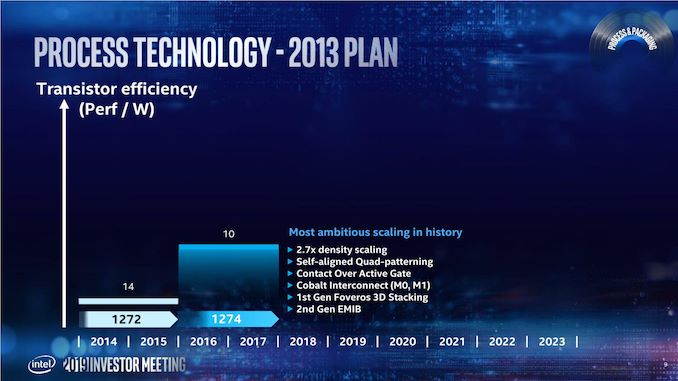

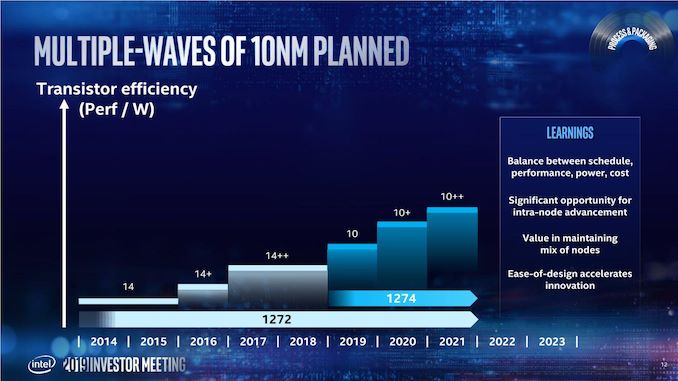
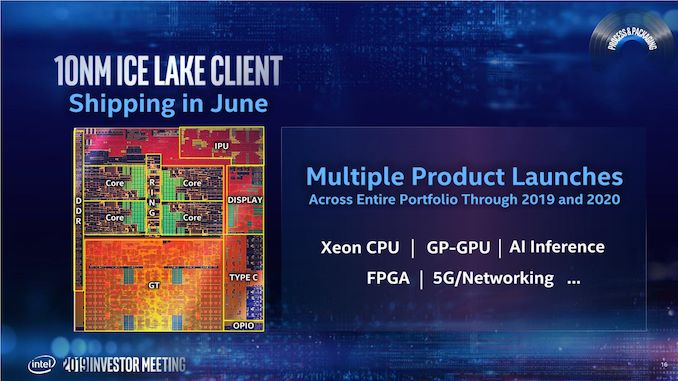
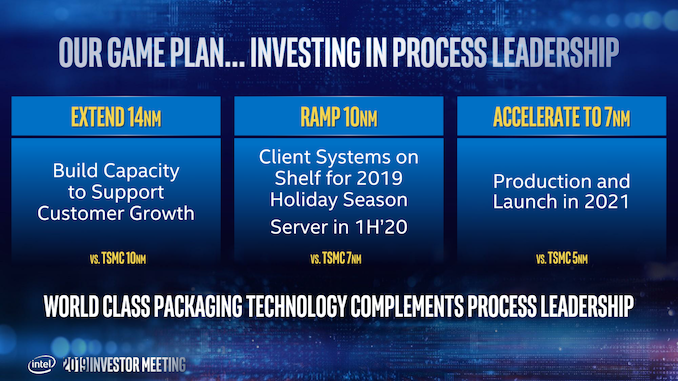
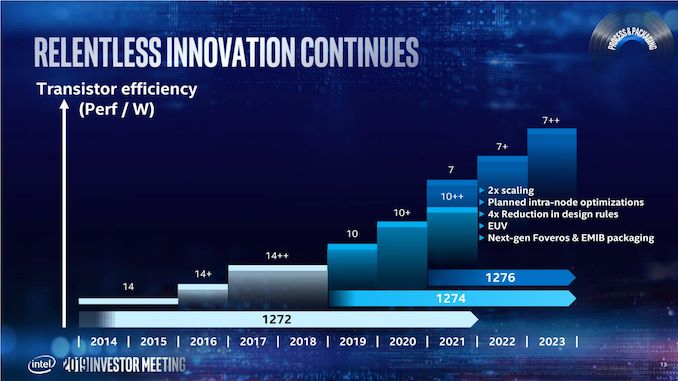

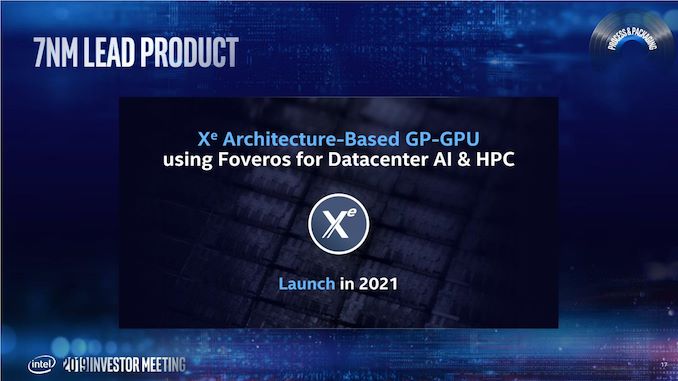








237 Comments
View All Comments
saratoga4 - Wednesday, May 8, 2019 - link
>Intels 14+ and 14++ processes extracted more than 20% more performance (from Broadwell to Whiskey Lake) from the process since its inception.Shouldn't that be from Skylake to Whiskey Lake? Broadwell and Skylake were both 14nm (non-plus).
Zizy - Thursday, May 9, 2019 - link
Yeah, they are mixing some ISA gains by BW->SL to the number. Actual process performance improvement is lower.tommo1982 - Wednesday, May 8, 2019 - link
I believe I have become an AMD fan. Reading INTEL related news doesn't excite me, whereas AMD's is interesting. I'm not even reading most of the news about INTEL. Partly because their naming sense is horrible. I don't know which 'Lake' they are going on about anymore.wiyosaya - Wednesday, May 8, 2019 - link
Agreed. At least they could follow the rainbow in their lake scheme, that would make some sense, IMO.Opencg - Wednesday, May 8, 2019 - link
Im excited to see what AMD and intel release this year but as a gamer its alot easier to be excited for AMD. Mainly this is because they have more ground to gain or may be willing to do what their competition wont. While the 9900k is king AMD has promised on par performance and this will likely be true. And in graphics nvidia wont be comming out with anything exciting this year. The gpu prices have been relatively high and it will be interesting to see what AMD offers with the cost reduction tech in navi. Navi releases this year will also foreshadow a second navi release next year that will go head to head with nvidias next generation. If nvidia continue to make poor gaming gpu designs AMD could even overtake them. Exciting times indeedRSAUser - Thursday, May 9, 2019 - link
Rumors state Navi had issues, so expect it to run hot again, but probably at a competitive price point as GDDR6 is a lot cheaper than HBM2.eva02langley - Thursday, May 9, 2019 - link
Who cares if it is not really more efficient than Vega 7nm, as long as the price/performance ratio is similar to Polaris, I will be happy and many people will be to.I don't mind paying 75W more for a GPU at full load. It is literally peanuts in power saving... and that is at a worst case scenario.
Opencg - Thursday, May 9, 2019 - link
if it has issues I would look at the super obvious and highly probable reason before I would say "expect it to run hot". its multiple chips trying to present as a single gpu. the real goal here is to do better than sli / crossfire have done in the past. I remember sone titles doing worse with 2x gpus than with one. the main point is that you want progammers and old games to be able to use navi like its a single gpu without heavy losses. I think amd will bring us closer than we have ever been. but it will still be a highly vairiable performer depending on the titles you bench. reviewers will have their work cut out as consumers will want to check EVERY games benchmarksTargon - Friday, May 10, 2019 - link
Navi doesn't use a chiplet/CCX design, it's a normal GPU.HStewart - Wednesday, May 8, 2019 - link
Just for information, "Lake" names are suppose to be internal and not for the public. What matter is how the products do - desktop computers is bad place to judge intel by. Compare a high end 4Ghz + notebook now to ones that were first out with Skylake only being 2Ghz or so and half the cores that is difference of newer 14nm vs original 14nm.